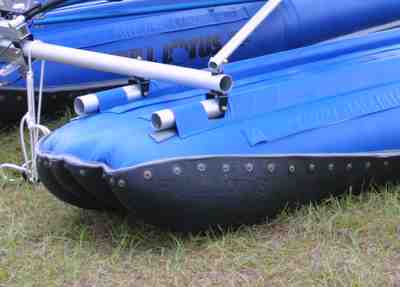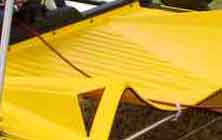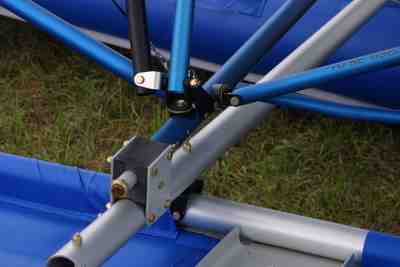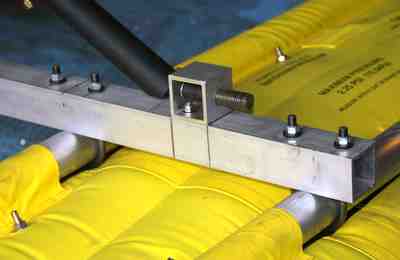| The Full Lotus float system has been on the
market since the mid 1980's. They were designed to be light and
rugged, and over the years have become one of the best selling float
systems on the market. The Full Lotus system
came about because anything being built for ultralights at the time
was being done by small under funded back yard operations, building
floats by using the "R&D" method. With R&D standing for "rip off and
duplicate." They learned they were doing something wrong when you
called to complain that it didn't work or broke.
Full Lotus on the other hand had the finances to
design and develop and test a float system, from the ground up using
technology that was not available to the "R&D" group. This system
was the number 1 float system for ultralights at the time.
The following is based on knowledge from over 5,000 hours of float
flying on 158 different float and amphibious ultralight style
aircraft. Plus personal installation, test flying and adjustment of
floats on 145 ultralight category aircraft since 1978.
Common Full Lotus problems
|
UV - The Full Lotus float
mounting area is made from materials that degrade over time
with exposure to sunlight. For this reason Full Lotus uses two
layers of material on the top of their float in the float tube
mount area.
(Note: very early models of the Full Float only used 1 layer.)
The first layer is exposed to the UV and is
sacrificed to protect the second layer. Pilot's who have
floats with a damaged outer layer, or a layer that has been
removed for whatever reason should inspect this area of their
floats regularly. Remember this is the area that connects your
plane to the float. It is being subjected to extreme speed,
and pressures during take off and landing.
Inspection of the threads holding the
mounting material onto to the top of the float should also be
an area of inspection for UV damage. |
Bladders - When flying on Full
Lotus floats there are a number of things that you should have
near by.
- Pressure gauge for checking air pressure
in each bladder of the float prior to each flight
- Air pig or pump for refilling bladders
- Spare bladders for both front and rear of
float
- Make sure to fly with a bladder repair
kit in your tool kit.
It is important the
Full Lotus float
system be checked for proper inflation before each flight.
Under inflation of the bladders can cause the bladder to move
inside the float, which will eventually cause it to leak. Over
inflation can lead to a bladder exploding on landing causing
loss of floatation.
Bladders should also be removed several
times a season and checked for water. The bladders will
collect water from osmosis, and condensation. Several pilot
have reported accumulations of over a gallon of water in their
bladders!
Remember this water is able to MOVE. During
lift off it will move to the REAR of the float. This can cause
loss of control due to improper C of G. Unlike regular floats
which can be pumped out the only way of removing the water the
Full Lotus system is to remove the bladders.
One pilot flying his craft on floats in
winter reported over 40 lbs of water had frozen into ice in
the rear of his floats! |
| Zippers - Several years ago
Full Lotus updated the way that the top and bottom sections of
their floats were held together. The older system used plastic
zippers to join the two halves together.
There were apparently reports of failure of
this system. In November of 1998 Full Lotus issued a
"CEASE FLYING" directive for their float
system. It basically said to stop flying on the float until a
FREE at the time update was installed. |

This is the newer style of system. |
| Step Area - The step area of
the Full Lotus float has been modified several times. The
first modification replaced the wood material used at the step
for support with metal. It was found that the wood rotted with
time and exposure to water. The second
modification was the addition of a set of small bladders
located in the step area of the float. Pilot's of heavier
ultralight aircraft with double surfaced wings were reporting
problems getting airborne.
The problem was traced to the float support
tubes bending when the pilot rotated for lift off. This
allowed the front of the float to move up but kept the back of
the float on the water preventing lift off.
The bladder system stiffens up the float in
the middle. Experience has shown that while this helps, it
also suggested that thicker walled tubing be used for
float support. The recommended tubing even with sleeves is
just not rigid enough when used on heavier ultralight aircraft
requiring 40 to 50 mph to lift off. |
Spray - Full Lotus floats are
very wide and the spray coming off of them is considerable. This spray can enter the prop area in a pusher
configuration, which will cause loss of thrust, and could
result in prop failure.
considerable. This spray can enter the prop area in a pusher
configuration, which will cause loss of thrust, and could
result in prop failure.
Many manufacturers and owners of trikes, and
other pusher aircraft are now installing splash rails on the
side of the floats to help prevent this. In the case of trikes
a splash pan such as shown here can be installed.
The other problem area is the tail section,
of craft that are mounted low on Full Lotus floats, with the
tail section directly to the side or behind the float. For
demonstration purposes picture a spray of water 2 feet wide
coming off the floats and hitting the tail section at 45 mph.
It is recommended that any water coming off
the floats be prevented from striking flight controls such as
the horizontal stabilizer, rudder, and elevator. |
| How to mount the Full Lotus
float system on your ultralight aircraft. |
| Many owners of Beaver's,
Quicksilver Challengers, L'il Hustler's, Merlin's, etc. use
their original landing gear with some minor modifications.
This requires a lot of fabrication of parts,
and drilling of tubing that has to be re-drilled if the floats
are not mounted correctly the first time.
|
 |
| A simpler installation is to
use the original landing gear when possible and install square
tubing below it. Then use U bolts to connect your landing gear
to the round tubes used on the Full Lotus system.
Using this system no holes need to be
drilled into the float tubing or fabric AND the floats can be
moved fore and aft by just venting air from the float and then
refilling them in the required position. |
 |
|
| Drag - Pilot's report lower climb rates when flying
on Full Lotus floats versus aluminum, fiberglass, composite or wood
floats. They also report needing higher rpm
settings to fly at the same speed on Full Lotus floats versus more
the more aerodynamic shaped fiberglass and aluminum floats.
On two identically powered and propped Challenger
aircraft one flying on Full Lotus floats the other on Puddle Jumper
floats the climb rate for the Full Lotus equipped craft was 25%
less, and the cruise rpm had to be increased to 6400 from 5800 to
maintain the same airspeed. The other problem is that most Challenger float installations make use of the landing gear to mount the floats. This puts the tail section directly in the path of the spray coming of the floats. Which decreases take off performance and can lead to structural damage to tail supports, and control systems. Two systems that work considerably better on the Challenger are the Puddle Jumper float, and the Key West Float system, with my preference being for the Key West. |
Specific Full Lotus aircraft installation
problems.
|
| In all of the cases above we have talked about
pusher aircraft. Now lets look at aircraft in a tractor
configuration. A number of problems have
been reported when using Full Lotus 1200 or 1260 floats on
craft such as the Merlin, Rans Courier, Rans Coyote, Kitfox, Avid,
L'il Buzzard and L'il Hustler.
The reported problems are
- the submersing of the front of the floats when
taxiing, especially right after the throttle has been backed down
- the submersing of the front of the float while
taxing in rough water
- being able to get on the step and take off with
one pilot but NOT being able to get on the step when two pilots
are on board
These problems can be traced to floatation. In my
opinion the 1260 floats do not have enough floatation in the front
section of the float for most two place, tractor aircraft.
In most pusher configuration aircraft the weight
put on the craft is distributed over the full length of the float.
In the case of the Challenger front pilot is supported on the front
section of the float, the pilot sits on the step or middle section
and the fuel and motor sit on the rear section.
In the case of MX the pilot(s) sit in the step
area, the motor and reduction on the rear section and the fuel on
the nose section.
On a tractor aircraft the full weight of the
engine sits on the front section, with two pilots and full fuel
normally located near or on the middle area of the float.
In the case of tractor engine, tandem seating
craft the weight is spread out more evenly but still ONLY towards
the front of the plane. This is why the craft becomes a submarine on
the front end when you taxi in rough water, or back the power down
quickly.
When pilots adjust the float forward for more
floatation they can't get off the water because the step is in the
wrong location. The plane just plows through the water nose high a
lot like a boat with too much weight in the rear. |
| Trike aircraft present also have problems with the Full Lotus Float system.
Trikes do not have a tail with a control system to help force the float up on to the step.
Trikes center of lift changes as the control bar is is moved forward and aft.
A system that was designed from the ground up to work on Trike aircraft is that designed by Krucker Manufacturing of Sudbury Ontario. The Krucker system is very aerodynamic and has two steps. These steps are specifically positioned on the float to work with trikes.
As the trike picks up speed the second step helps force the front step out and the floats out of the water. The system is extremely light, durable, easy to mount and can be equipped with a very light weight, quick and efficient amphibious float set up.
Krucker also has a variety of accessories specific for trike application. These guy just don't build trike specific parts - they fly TRIKES so they know what is needed.
For more information:
Krucker Manufacturing Ltd.
1400 Barrydowne Road,
NORCAT Building,
Sudbury, ON, Canada.
P3A 3V8
Phone: (705)521-8324 Ext.217
: (705)521-1040
e-mail jp@4kru.com |
Click
here to go to our FEATURE:
Flying
on floats - things pilots should know! |
|
Full Lotus Safety Advisory
.
Main Index |
|
|
Ultralight Aircraft News Web Magazine Covering the World of Ultralight Aviation .
You may link to these pages or print
them out for your own personal use, but no part of this
publication may be copied or distributed, transmitted, transcribed,
stored in a retrieval system, or translated into any human or computer
language, in any form or by any means, electronic, mechanical,
manual, or otherwise, without the written permission of Ultralight News.
By copying or paraphrasing the intellectual
property on this site, you're automatically signing a binding contract
and agreeing to be billed $10,000 payable immediately. Copyright Ultralight News
|



 considerable. This spray can enter the prop area in a pusher
configuration, which will cause loss of thrust, and could
result in prop failure.
considerable. This spray can enter the prop area in a pusher
configuration, which will cause loss of thrust, and could
result in prop failure.

